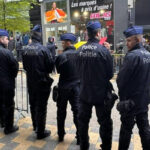Christopher Nolan's latest proof of virtuosity, Oppenheimer, is released in Italian theaters at the same time as the re-release of another masterpiece, Kaze tachinu (The wind rises), by Hayao Miyazaki. Tout se tient: both films in fact represent each from its own point of view a reflection on man's fate in front of science, technology and his very history, which is nothing but the abandonment of the state of nature and happy unconsciousness to enter the spiral of progress.
Paradoxically, while the rather pessimistic Miyazaki, even in the poignant tragic nature of the story told (the fictionalized biography of the father of the Zero fighter, Jirō Horikoshi (1903-1982)) succeeds in the end in writing a double message of optimism, Nolan instead leaves us with the nightmares of a man who was aware that he had destroyed the world, one way or another. Miyazaki's reflection is left to the dreamlike dialogues between Horikoshi and his spiritual mentor, the Italian engineer Giovanni Battista Caproni (1886-1957): when the latter questions the young Japanese designer by telling him that airplanes however wonderful are machines of death, posing him the dilemma" between a world with pyramids and a world without pyramids, which do you prefer?" he gets the answer of irresponsible innocence: "I think I want to design beautiful airplanes." In the film's finale, in a graveyard of flying machines representing Japan's wartime catastrophe, the beauty of the Zero fighters, with their pilots saluting Horikoshi and Caproni as they go to join the heavenly procession of the War Fallen, manages to justify the terrifying weight carried on the shoulders of those who made those planes. And if the collective responsibility of human history is shared as an inescapable destiny, that of the individual, on the other hand, is summed up in the loving imperative "Live!" that the ghost of Horikoshi's wife leaves for the widower before disappearing.
Instead, Nolan fails to leave a message of optimism. Neither collective, with the masses excited by war victory and unaware that they are under the same sword of Damocles unleashed on Hiroshima and Nagasaki, nor individual, with the film's protagonist tortured by the thought of having triggered a chain reaction not only of atomic but also of events that will one day lead humanity to obliterate itself.
Nolan's film is a faithful biography of the "father of the atomic bomb" Robert Oppenheimer (1904-1967), with minor deviations from actual history so irrelevant as to be almost imperceptible: Oppenheimer talking about "death camps" in 1939, (when the Holocaust had not yet been consummated in the lagers), Secretary of War Henry L. Stimson deleting Kyōto from the list of cities to be bombed because he had been there "on his honeymoon," a U.S. flag with the wrong number of stars, the presence of African-American scientists among the (actually all-white) staff at Los Alamos, Oppenheimer presented as heading the entire Manhattan Project and not just the Los Alamos laboratories, a quote from Proudhon mistaken for Marx's "Capital."... Aside from the errors, some of the director's and screenwriter's interpretations have raised minor misgivings, such as wanting to include the (unhistorically established) incident of the cyanide-poisoned apple left by the young protagonist to one of his professors and having told the story of the clash between Oppenheimer and Lewis Strauss (1896-1974), Eisenhower's secretary of commerce in pectore and chairman of the U.S. Atomic Energy Commission, openly taking sides for the scientist. Strauss is thus portrayed in a markedly negative way, according to the liberal stereotype that saw the physicist - laic, progressive, a member of the sophisticated and libertine upper class, opposed to the development of the H-bomb and in favor of sharing atomic technologies with the USSR - as a positive hero, while the Republican politician - highly observant Jew, conservative, critical of Oppenheimer's adulterous sexual habits, supporter of a policy of deterrence and firmness with the USSR as well as coming from humble origins - as the vilain.
But the political affair between Strauss and Oppenheimer almost gets in the way of the main narrative, which is, of course, that of the making of the atomic bomb. And which represents Nolan's reflection on the fate of humanity. As with Miyazaki\Horikoshi's planes, Nolan\Oppenheimer's nuclear physics is greeted with boyish innocence. The discovery of the chain reaction in 1938 is received with scenes of discomposed jubilation among scientists, despite the immediate awareness that it opened the door to a military employment of uranium disintegration. When this employment arrives and materializes by vitrifying a chunk of the New Mexico desert and then charring two Japanese cities, the realization that he must bear an unspeakable moral burden grows in Oppenheimer's consciousness. The justification he rationally tries to give - and give to himself - is that the use of nuclear energy as a weapon is inevitable, but the sooner it happens, the sooner it will be so terrifying that humanity will no longer make use of it. A kind of moral "vaccine." The price, the real human sacrifice, will be the 250,000 dead of Hiroshima and Nagasaki and the damnation of his own conscience.
Yet this explanation is not enough for Oppenheimer to find the sad serenity that Horikoshi gains in Miyazaki's work by its end. Nolan places a great deal of emphasis on a colorful episode in the Manhattan Project: the hypothesis, advanced by Edward Teller, that a nuclear explosion could trigger a process of atmospheric hydrogen nuclear fusion and ignite the air all over the planet. This hypothesis, immediately reduced to a remote possibility by calculation, is much cherished in a certain narrative about the Los Alamos epic, but it was utterly marginal. Nolan elevates it to a paradigm of Oppenheimer's sin of hubris: the world will not be destroyed by a single nuclear blast, but that same first explosion will nonetheless trigger the future atomic apocalypse. Oppenheimer will be burdened throughout his life with the doubt that his only moral justification for the holocaust of Hiroshima and Nagasaki - to succeed in making all the rest of humanity escape the same fate - could be rendered futile by the arms race that he had contributed to start.
The problem of man's relationship with technological progress is thus approached with conclusions far removed from the excelsior of the late 19th century or the techno-enthusiasm of contemporary Prometheanist. What man has discovered cannot be re-buried in the sands of ignorance. We can see the heroic, epic, aesthetic aspect of it and manfully load on our shoulders the unbearable burden of the other side of those medals, as Miyazaki proposes, stubbornly contrasting the moral imperative "Live!" with the uncertainty of the future and the harshness of the present. Or, Nolan suggests, stay in front of the anguish of knowing that the first fire stolen by Prometheus will sooner or later set the whole world on fire. And despite our best efforts, there is absolutely nothing we can do about it because the chain reaction can no longer be stopped.
Editor of the Machiavelli Study Center's blog "Belfablog," Emanuele Mastrangelo has been editor-in-chief of "Storia in Rete" since 2006. A military-historical cartographer, he is the author of several books (with Enrico Petrucci, Iconoclastia. La pazzia contagiosa della cancel culture che sta distruggendo la nostra storia e Wikipedia. L'enciclopedia libera e l'egemonia dell'informazione).









Scrivi un commento